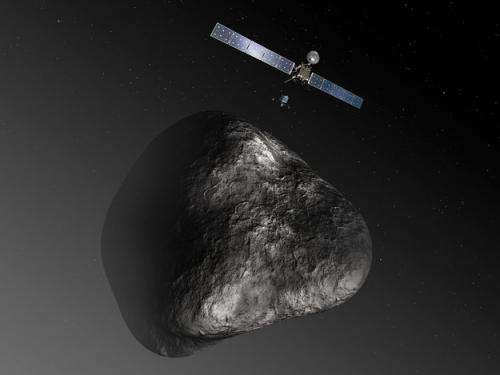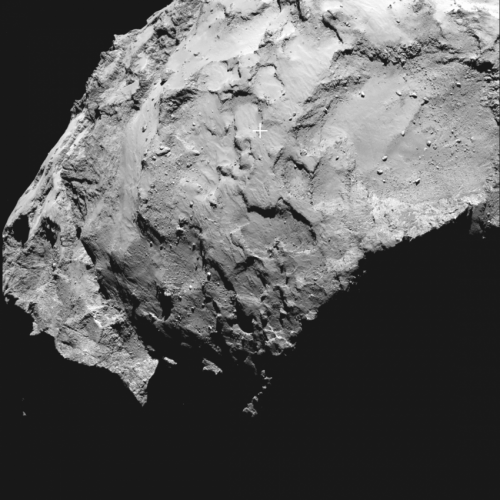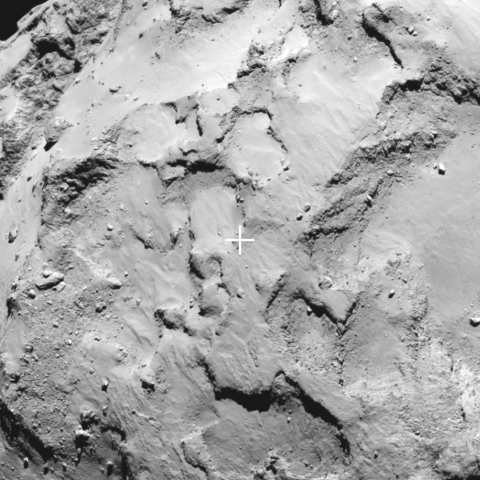Living on the edge: Rosetta's lander philae is set to take the plunge

This is a very exciting time for space science in general and for the Rosetta spacecraft in particular. A little more than a month after arriving at comet 7P/Churyumov-Gerasimenko, Rosetta has mapped its surface well enough to help scientists choose a location to set down Philae, the first-ever comet lander. Or, at least, try to. Here to tell us more about the recent mapping of comet 7P/Churyumov-Gerasimenko, the announcement Philae's landing site, and what comes next for the Rosetta spacecraft is Dr. Claudia Alexander of the Rosetta mission.
Astrobio.net: Thank you for joining us to talk about this mission and the upcoming landing. Would you please tell us a bit about yourself, about what you do at NASA in general, and on this mission in particular?
Dr. Claudia Alexander: I've been involved in quite a few historic Outer Solar System missions—the Galileo mission to Jupiter, the Cassini mission to Saturn. I was chosen for Rosetta in part because of my experience with these missions and my background in comet research. Representing NASA on a mission like this is a privilege! The European Space Agency is a unique space consortium of its member states, and is unlike NASA in many ways. Yes, there are cultural differences between Europe and America! I know you'll be shocked to hear it. Being part of this inter-agency collaboration includes finding ways to provide support, and be a good partner. We wanted to 'be our partner's best partner' in terms of accomplishing Rosetta. We think of Rosetta as an excellent example of inter-agency, international collaboration to accomplish major things in space exploration. This is going to be more likely how we do things in space in the future, as collaboration helps to mitigate the cost.
Astrobio.net: I would like to paint a picture for our readers. What ESA and NASA are about to attempt has never been tried before. Comet C-G is a dark, slightly mushroom-shaped object 4 kilometers (2.5 miles) across at its widest point. Thanks to Rosetta's detailed maps, we now know that the surface is very uneven, with deep slants and large boulders. Philae will be dropped onto this uneven surface from a distance of 1 km above the comet as it rotates freely in space. No active steering will take place during descent. In that sense, Philae's fall will be a bit like the 7 minutes of terror that safely landed Curiosity on Mars. Can you tell us why was this technique chosen for Philae?
Dr. Claudia Alexander: Based upon the new high-resolution images I think our best tool was the selection of landing site "J" itself, with its gently sloping terrain. I was most worried that the surface was too soft, so picking a surface that's not completely level is a good idea. Let the lander 'slide' to a stable position rather than relying on the drill to affix it to its landing spot.
Astrobio.net: Philae is projected to land somewhere in the J zone. What can you tell us about the various zones on comet C-G? We understand that in comparison to many places on comet C-G, the J zone is relatively flat and boulder-free. What else can you tell us about why this area of the comet was chosen as a landing spot?

Dr. Alexander: It will be more like 7 hours of terror! We don't know exactly how long it will take to fall, since the comet has so much less gravity than Mars, and there's an intermittent atmosphere. As we know from the challenges of landing on a surface like that of Mars, creating parachutes, or crash-balloons, or other means of delivering the lander, all add mass to the payload, and require telemetry that is perhaps not available. This mission was conceived in 1995 (by comparison, the Mars Pathfinder landing was in 1997). The original NASA participation in Rosetta's landing was cancelled back in the '90s with the rationale that it was too risky. And with the change of target (we were originally scheduled to fly to comet Wirtanen, but a problem with the launch rocket caused a delay and a change to a larger comet) the lander itself was not designed for such a large body. Moreover, unlike with the Mars missions, where the surface of Mars had been well mapped and explored, ESA is attempting to do first reconnaissance and landing all at the same time. So we all should recognize that the landing is risky, and have a healthy appreciation for the engineering challenges.
Astrobio.net: We currently know very little about the surface of any comet, much less the comet on which Philae is about to make a touchdown. C-G's surface could easily turn out to be tougher than a nails, making it challenging to drill into. Or, it could be so soft that Philae sinks down into it. There are various tools onboard the lander in case of either contingency. Based on the new high-resolution images, which set of tools do you think will come most in handy and why?
Dr. Alexander: It was more of a process of elimination of terrible options, we chose the least bad of all the options. Every site had significant flaws. In one case the spot was not favorable to the CONSERT experiment, an experiment that will conduct a sort of 'ultra-sound' of the nucleus. In other cases, there was not a good day to night variation in illumination, meaning that, aside from losing good diurnal science, we would not optimize the batteries (which can be re-charged). While there are many zones on the nucleus that are scientifically interesting, the safety of the landing was the paramount concern.
Astrobio.net: Comet C-G is coming closer to the Sun everyday. As it does, it will become more and more active. Physically speaking, what could change about the comet between now and the time that Philae takes the plunge that might make this an even more daring maneuver?
Dr. Alexander: We are quite worried about anomalous 'activity'—if the nucleus starts spewing gas and dust in a manner we hadn't anticipated. It's kind of like predicting the weather for a road trip. You want to go camping, but not in a thunderstorm. And as everyone knows, we are generally good at weather prediction, but it's not perfect.
Astrobio.net: Once Philae has made a successful decent and is secured to the comet's surface, what is the first thing it will do?
Dr. Alexander: The first thing is a panoramic image, of course! With the CiVA camera. You have to see what's going on.

Astrobio.net: Philae has 12 different instruments on board. My personal favorite is CONSERT (Comet Nucleus Sounding Experiment by Radio wave Transmission). For Comet C-G, CONCERT will bounce low-frequency waves through its center, creating the first-ever image of a comet nucleus. CONCERT is my favorite instrument because it will continue to work even if Philae lands upside down! Which Philae instrument is your favorite and why?
Dr. Alexander: Yes, I confess that CONSERT is my favorite! I look forward to seeing if/what sort of layers exist under the surface! But in order to not be a copycat, I'll pick another favorite: APXS (The Alpha-particle X-ray Spectrometer). This is an instrument that is also on Curiosity (at least a different version of basically the same instrument). It can detect what sort of minerals are embedded in soils and rocks. If there are any rock hounds out there, you know that part of the fun is looking at a rock with your magnifying glass for the beautiful minerals that are inside. Any rock (igneous, sedimentary, etc) are made of minerals, some quite colorful, and those minerals in turn are made of molecules. It's very interesting to know what minerals exist in extra-terrestrial environments. We have no idea what nature is capable of! The process of identifying the elements will also tell us a bit about any physical processes that might have been involved. So I think this experiment is quite exciting.
Astrobio.net: What's next for Rosetta after Philae takes the plunge?
Dr. Alexander: Actually the Philae mission is only about three days. After we drop Philae, that's when the Rosetta orbiter's prime mission truly begins! We start a yearlong period of study as the comet goes around the Sun. We'll get a chance to study how it warms up, and how it responds to the Sun's radiation. We want to have an opportunity to fly through a jet! And the post-perihelion side, on the outbound leg, is not only the dustier side of the comet, but it's proven to be the more active side, so we hope to study seasonal changes on this target, and a whole new regime as we enter the dustier side with its dynamics. The mission officially ends on Jan 1, 2016.
Source: Astrobio.net
This story is republished courtesy of NASA's Astrobiology Magazine. Explore the Earth and beyond at www.astrobio.net .



















